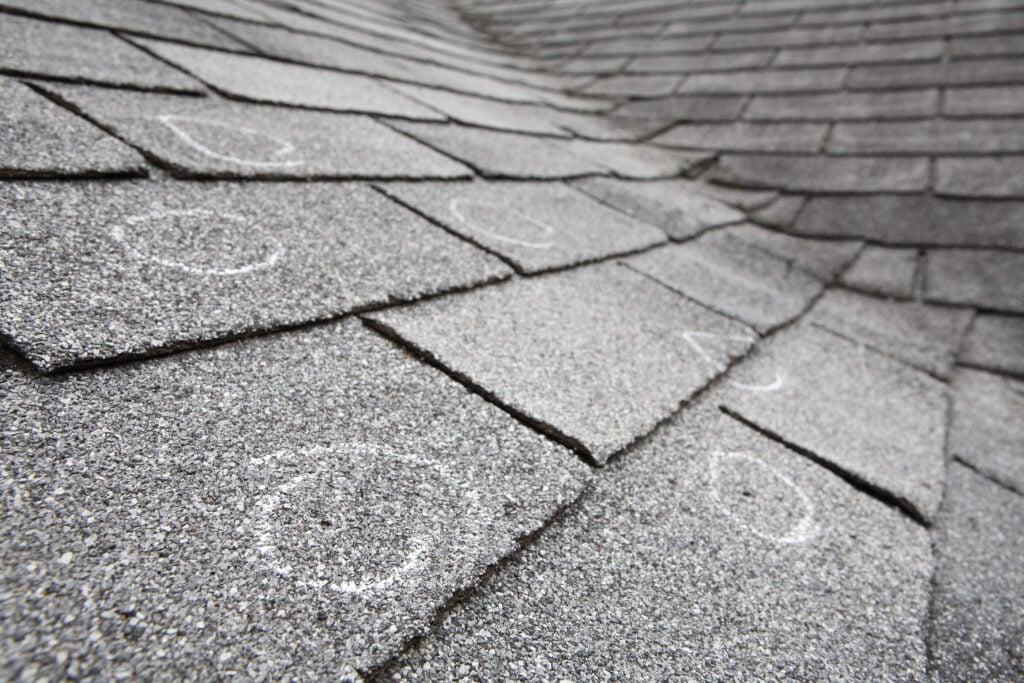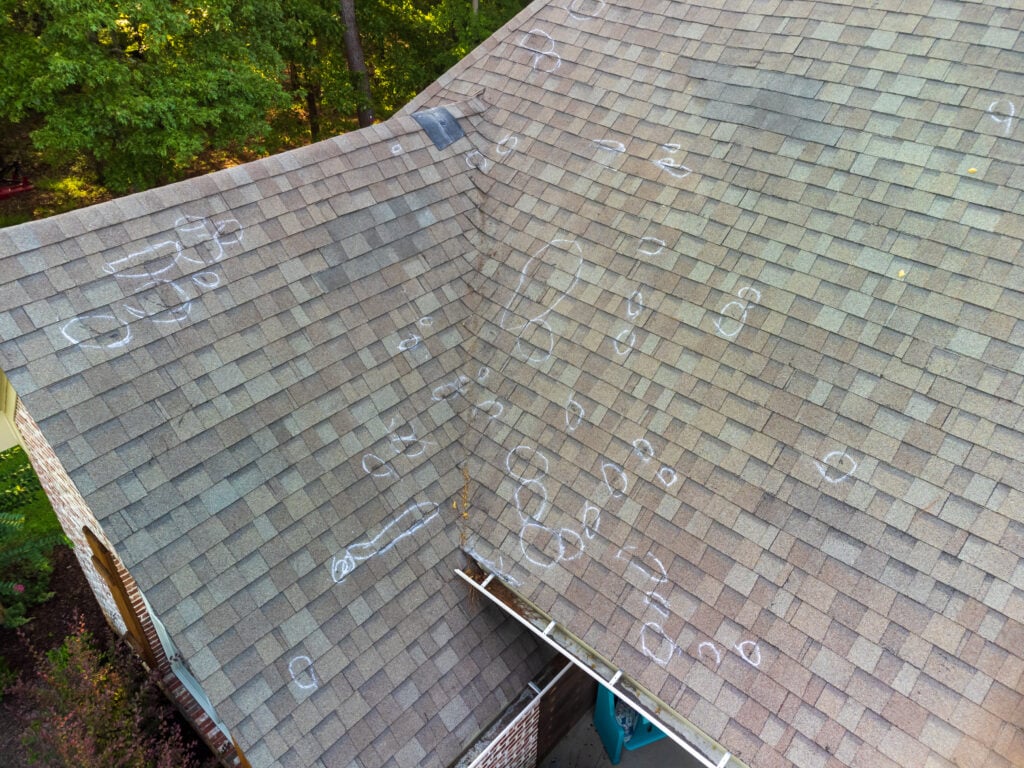Roof damage can be confusing to identify, especially when you’re dealing with similar-looking issues that have completely different causes. Two of the most commonly misidentified roofing problems are hail damage and blistering. While both can appear as raised or damaged areas on your shingles, understanding the key differences between hail damage vs blistering is crucial for proper repairs and insurance claims.
As experienced roofing contractors serving New York homeowners, we’ve seen countless cases where these two types of damage get mixed up. This confusion can lead to improper repair approaches, denied insurance claims, and unnecessary expenses. That’s why we’ve put together this comprehensive guide to help you understand exactly what you’re dealing with when you spot damage on your roof.
In this article, we’ll cover:
- What hail damage looks like and how it occurs
- The characteristics and causes of roof blistering
- Key differences between hail damage and blistering
- When to call professional roofing contractors for inspection
- Steps to take for repairs and insurance claims
🔎 Understanding Hail Damage

Hail damage occurs when ice pellets fall from the sky during severe weather events, striking your roof with significant force. The size of hailstones can range from pea-sized to golf ball-sized or even larger, with larger stones causing more severe damage to your roofing materials.
Types of Hail Damage
Hail can cause several different types of damage to your roofing system:
Granule Loss: The most common form of hail damage involves the loss of protective granules from asphalt shingles. These granules protect the underlying asphalt from UV rays and weather exposure.
Exposed Mat: When granule loss is severe, you’ll see the black asphalt mat underneath. This exposure leaves your roof vulnerable to further weather damage and potential leaks.
Cracking: Large hailstones can cause actual cracks in shingles, especially if the roofing material is older or already brittle.
Denting: Metal roofing, gutters, and other roof components may show visible dents from hail impact.
🤔 What Is Roof Blistering?

Roof blistering is a completely different issue that develops over time due to trapped moisture or air within the shingle layers. Unlike the sudden impact damage from hail, blistering occurs gradually as your roof ages and experiences temperature fluctuations.
Types of Blistering
Blistering can appear in different forms on your roof:
Surface Blistering: These blisters affect only the top layer of the shingle and may not expose the underlying mat.
Deep Blistering: More severe blisters that penetrate deeper into the shingle layers, potentially exposing the mat underneath.
Ruptured Blisters: When blisters break open, they create an open wound in the shingle that’s vulnerable to water infiltration.
⚖️ 5 Key Differences Between Hail Damage and Blistering

Understanding the differences between hail damage vs blistering requires looking at several key characteristics. These differences help roofing professionals, insurance adjusters, and homeowners properly identify what type of damage they’re dealing with.
1. Cause and Timeline
Hail damage occurs suddenly during a storm event. You can often pinpoint exactly when the damage happened based on weather reports and storm timing. The damage appears immediately after the hail event.
Blistering develops gradually over months or years. There’s no specific moment when blistering occurs—it’s a slow process that happens as your roof ages and experiences temperature cycles.
2. Appearance and Pattern
Hail damage shows up as random spots across your roof surface where granules have been knocked off. The pattern is irregular and corresponds to where individual hailstones struck.
Blistering appears as raised, bubble-like areas on individual shingles. These raised areas are typically more uniform in shape and don’t show the random scatter pattern of hail damage.
3. Granule Loss Characteristics
When hail removes granules, you’ll see sharp, defined edges where the impact occurred. The granule loss often has an irregular shape that matches the hailstone’s impact pattern.
Blistering may or may not involve granule loss initially. If granules are missing from a blister, it’s usually because the blister has ruptured, creating a more uniform loss pattern rather than the jagged edges typical of hail damage.
4. Touch and Feel Differences
Hail damage creates areas where the surface feels rough or pitted. When you run your hand over hail-damaged areas, you can feel the depressions where granules were removed.
Intact blisters feel raised and soft when pressed gently. Ruptured blisters may feel similar to hail damage, but they’re typically located in the center of what was previously a raised area.
5. Age and Distribution Patterns
Fresh hail damage appears uniform in color—typically dark where granules are missing. Over time, weathering may cause these areas to fade or change color.
Blistering often appears in clusters or patterns related to specific manufacturing batches or installation sections. Older blisters may show different aging characteristics than the surrounding undamaged shingles.
🏡 Identifying Hail Damage vs Blistering: A Professional Approach
Proper identification of hail damage vs blistering requires systematic inspection techniques. While homeowners can learn to spot obvious differences, professional roofing contractors have the experience and tools to make accurate determinations.
Professional Inspection Techniques
Experienced roofing contractors use specific methods to distinguish between these two types of damage. They examine the damage pattern, timing, and characteristics to make accurate assessments.
Professional inspectors look at the overall distribution of damage across the roof. Hail damage typically affects exposed areas more than sheltered spots, while blistering can occur anywhere, regardless of exposure.
They also consider the home’s history and maintenance records. Recent storm activity supports a hail damage diagnosis, while gradual deterioration suggests blistering.
Tools and Equipment Used
Roofing professionals use specialized tools to assess damage accurately. These may include magnifying glasses to examine granule loss patterns, moisture meters to detect trapped moisture, and cameras to document damage for insurance purposes.
Professional documentation is crucial for insurance claims. Contractors take detailed photos showing the extent and characteristics of damage, which helps insurance adjusters make proper determinations.
| When to Call for a Professional Roof Inspection | Why It’s Important |
| After a Storm | Storms can cause hidden damage like leaks or weakened structures that professionals are trained to identify accurately. |
| Before Buying or Selling a Home | A professional inspection ensures there are no hidden issues, protecting your investment. |
| When Roof Damage is Suspected | Professionals can safely assess the extent of damage and recommend the necessary repairs to avoid further complications. |
| For Routine Maintenance | Regular inspections help extend the lifespan of your roof by identifying small issues before they become big problems. |
| During Insurance Claims | Proper documentation from professionals is often required by insurers to process claims smoothly and without delays. |
📑 Insurance Considerations

The distinction between hail damage vs blistering becomes critically important when dealing with homeowner’s insurance claims. Insurance companies treat these two types of damage very differently, which can significantly impact your claim outcome.
Coverage Differences
Most homeowner’s insurance policies cover hail damage as a weather-related peril. This means repairs from legitimate hail damage should be covered under your policy, minus your deductible.
Blistering, however, is typically considered normal wear and tear or a maintenance issue. Insurance companies rarely cover blistering repairs, viewing them as the homeowner’s responsibility for regular roof maintenance.
Documentation Requirements
For hail damage claims, you’ll need to provide evidence that a hail event occurred and caused the damage. This includes weather reports, photos of the damage, and professional inspection reports.
Insurance adjusters look for specific characteristics when evaluating hail damage claims. They examine impact marks, granule loss patterns, and damage to other property elements like gutters or siding.
Working with Insurance Adjusters
Professional roofing contractors can be valuable allies when working with insurance adjusters. Experienced contractors understand what adjusters look for and can help present your claim effectively.
Having professional documentation and assessment reports strengthens your position during the claims process. Contractors can point out damage that untrained eyes might miss and explain the technical aspects of the damage to adjusters.
👨🔧 Trust Kornerstone Roofing for Expert Roof Assessment
At Kornerstone Roofing, we understand how overwhelming roof damage can be, especially when it comes to distinguishing between hail damage and blistering. With years of experience and a dedication to honesty and quality, our family-owned team has become the trusted choice for New York homeowners.
We offer expert assessments, reliable repairs, and labor warranties of up to 25 years to ensure your home is fully protected. Don’t leave your roof to chance—contact Kornerstone Roofing today for a free inspection and personalized guidance!



